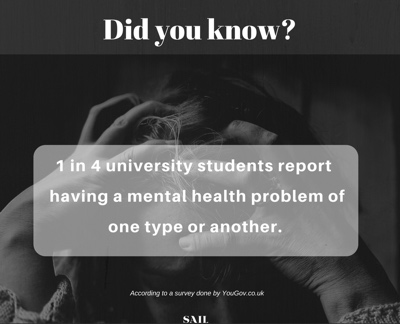Exploring the current indicators that prove the presence of mental health problems among the university students in UAE, and researching into the potential triggers.

Walking through universities corridors during an exams period and noticing the students’ state of mind can be alarming, but it can also be unknowingly dismissed as a natural reaction to stress. I was recently told by one of the university students that there are often lots of cases of fainting, vomiting, and hospitalization during the exams period. I too thought it was a natural stress reaction, but was it that simple?
Something urged me to look further into this and the reality was alarming, to say the least. Nowadays, one out of every four university students is suffering from a mental health problem. There is an increasing number of university dropouts across the world due to mental health problems, and I personally know of a case or two in the UAE. According to research, the top three mental health problems amongst university students are Depression, Anxiety Disorders, and Eating Disorders. This is a worldwide crisis that also affects our region – any conversation with university students will reveal that. If we fail to acknowledge this problem, the results could be catastrophic to the nation’s future, a future that depends on those youth and their achievements once they leave university and start their careers.

A few months ago there was a case of an Emirati teenager who seemed to have been struggling with depression. She started expressing her thoughts more and more on Twitter, and then one day she announced that she had enough of this life and bid her farewell to the world as she implied she’ll be leaving to take her own life. Thankfully this was averted as so many people reached out to her, whether they knew her or not, and tried to support her and get her the help she needed. But how many others have gone through the same and have not have gone viral as she did? Or didn’t have the courage to share it on social media and disappeared from this earth without anyone knowing what they were going through?
When I was exploring this subject and discussing this girl’s attempted suicide with people in their 50s & 60s, trying to gauge their input into the matter, the responses were worrying. I got responses such as:
- “What did a teenager like her see in life already to cause her this depression!”
- “She is just trying to get attention.”
- “This is all from watching western shows and the kids take ideas from there.”
I can imagine that these are the attitudes that the troubled youth are facing from their families, which might make it more difficult for them to handle what they’re going through, or in some cases, not get the help they need.
The big question that is always asked by the parents’ generation is what can possibly cause our kids to go through any claimed mental health problem? Well, there are so many causes. The research points to few major causes, such as:
- Social media exposure at a very young age and having their every life detail under a societal magnifying glass can take a toll on the youth. On the one hand, it triggers the fear of missing out (FOMO) and creates a compulsive need to keep checking their accounts to know what is going on around them. On the other hand, it shakes the self-confidence by the need for constant reaffirmation via likes and comments on their posts. This is without even mentioning cyberbullying and how damaging that is to the youth’s self-esteem and confidence. One research even went further to link the levels of anxiety, depression, body image problems, FOMO, and bullying triggered by each of the different social media platforms.
- The youth’s addiction to smart devices whether from phones to tablets can create “chemical imbalance in their brains that predisposes them to depression and anxiety”.
- Academic pressures are nowadays incredibly different from what they were 10 years ago. The workload imposed on the students from every subject they take in a week is easily equivalent to the workload I used to have spread over a whole month a decade ago. There seems to be an imbalance or too high of an expectation in the university requirements that expect students not to have a life, nor extra-curricular activities (which nowadays are expected from students to secure good jobs after graduation), nor other subjects during that same semester which would also have their own workloads.
- The knowledge that there is a very tough job market that cannot keep up with the surging numbers of graduates every year, this leaves many students on their last two years with the mental pressure to perform and overachieve through their grades, and by taking on many extra-curricular activities and internships to increase their employment chances.
- Genetically and environmentally, mental health problems are on the rise. Some studies show that depression rates have increased dramatically over the past 10 years worldwide.
The points above touch on only some of the reasons and triggers behind the mental health troubles of today’s university students. Many of these factors weren’t an issue a decade ago, and certainly not 20 and 30 years ago. Different times are resulting in different physiologies and require different measures. Now, more than ever, we need to take the youth seriously when they say they are stressed, or depressed. Now, more than ever, we need to actively work on establishing the right balance between university workload and social life. Finally, and most importantly, we need to ensure to we can provide the youth with help when they need it.
This article has been written as part of The UAE Rosalynn Carter Fellowship for Mental Health Journalism sponsored by Al Jalila Foundation.
P.S. If you’re facing any sort of mental health issue problems, please refer to this post for suggestions on how to get help.




1 Comment